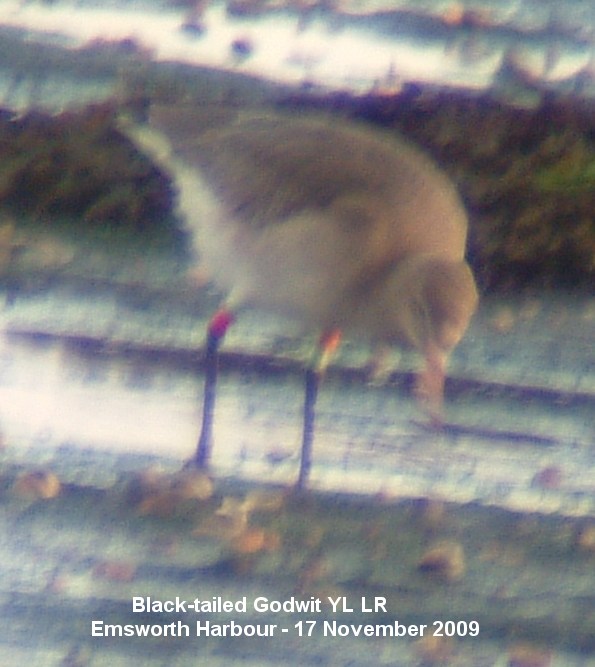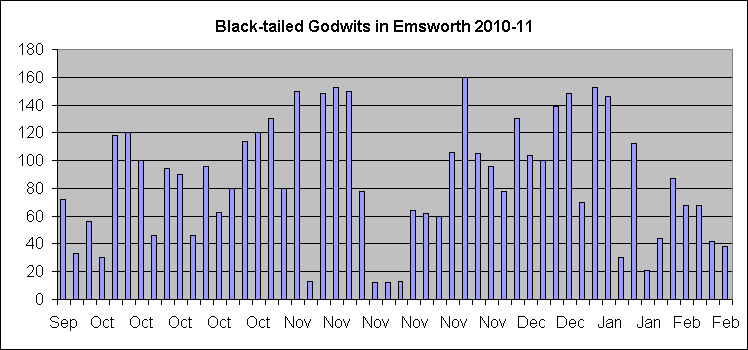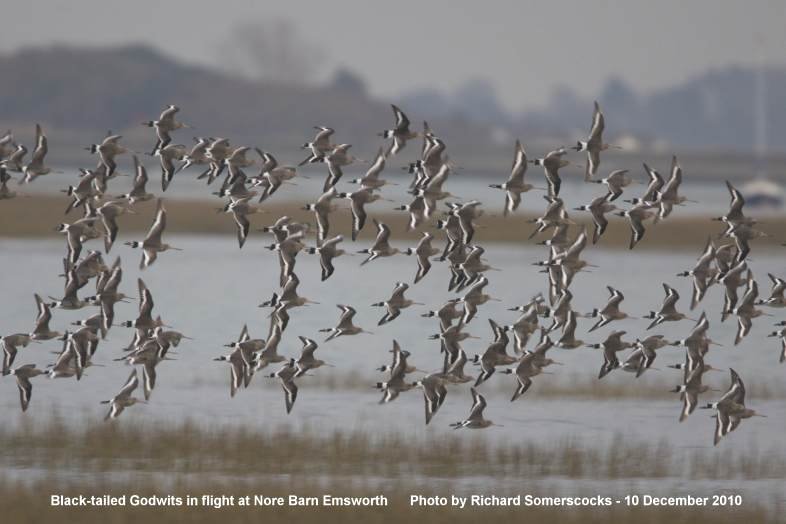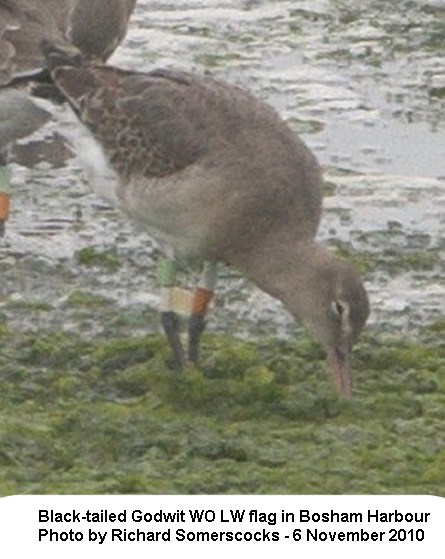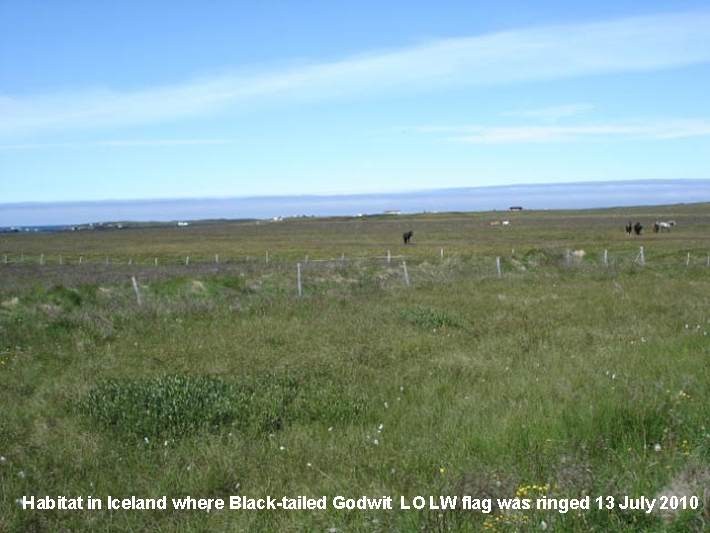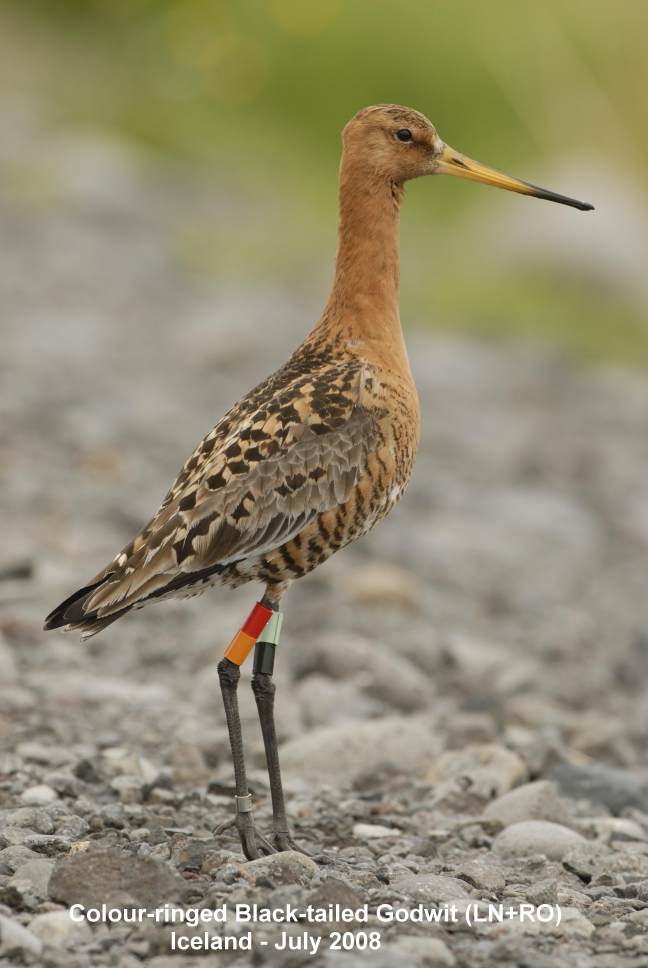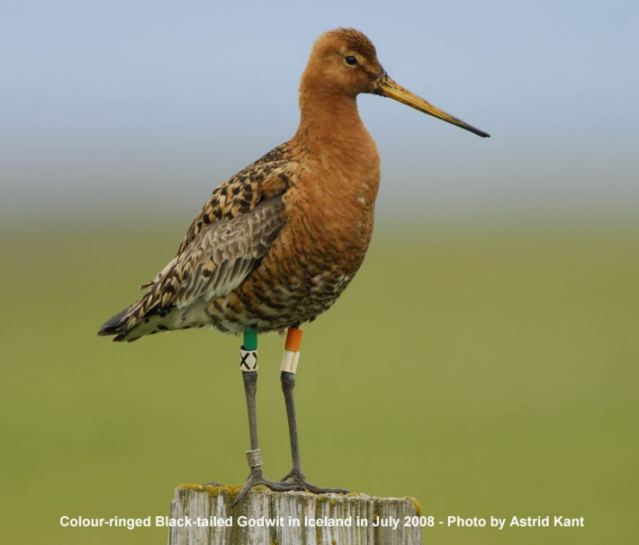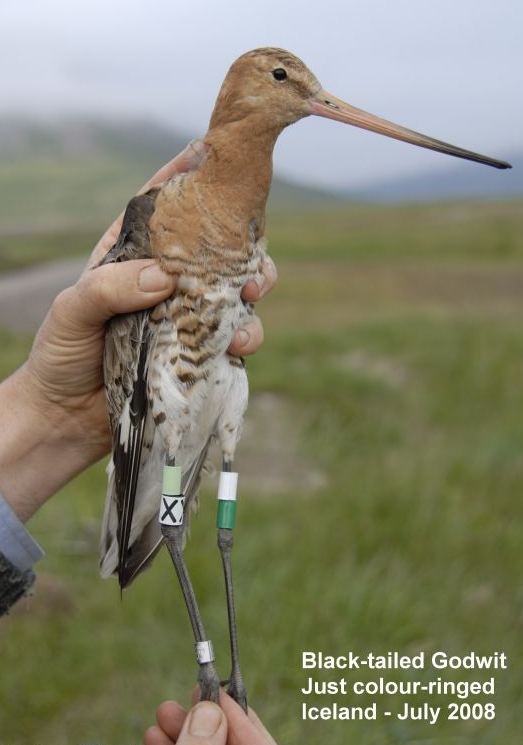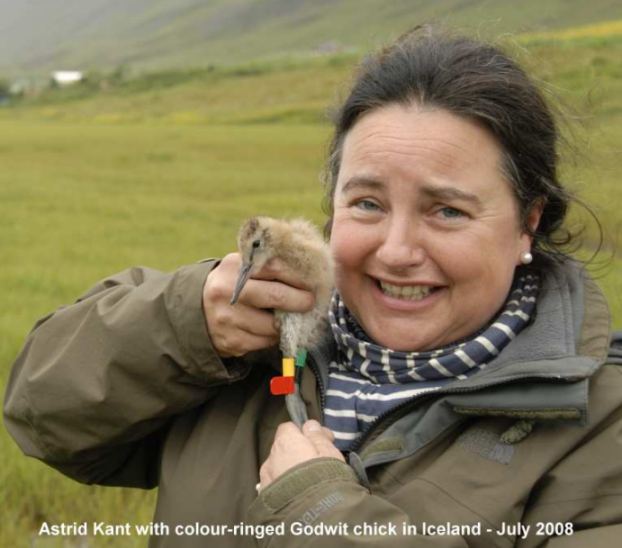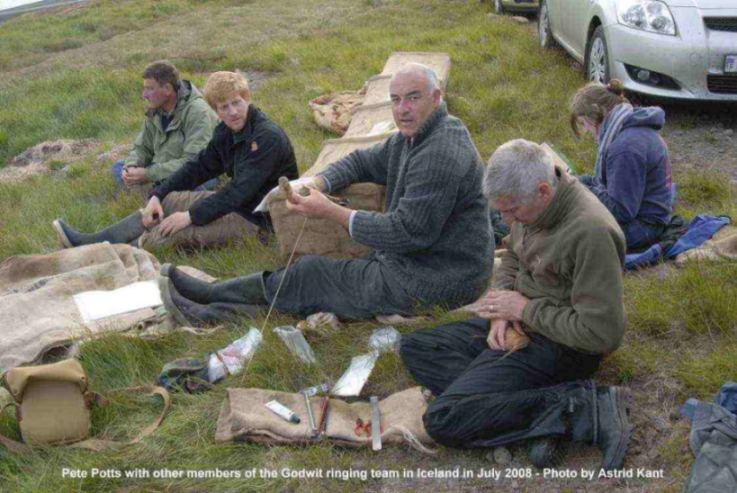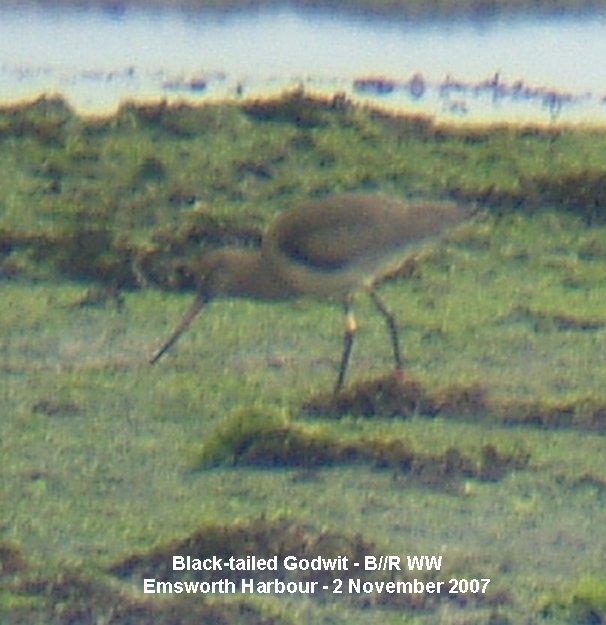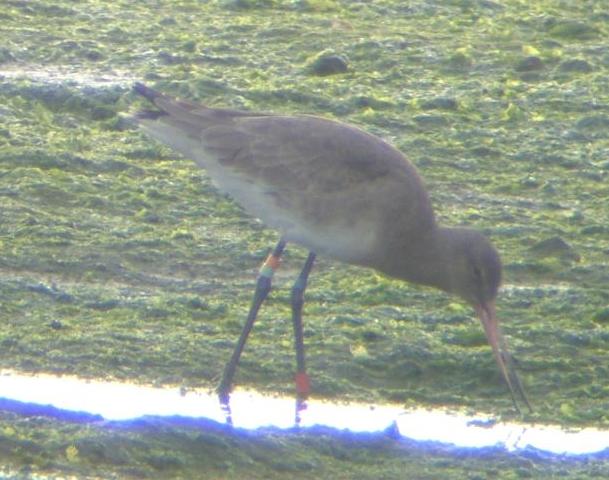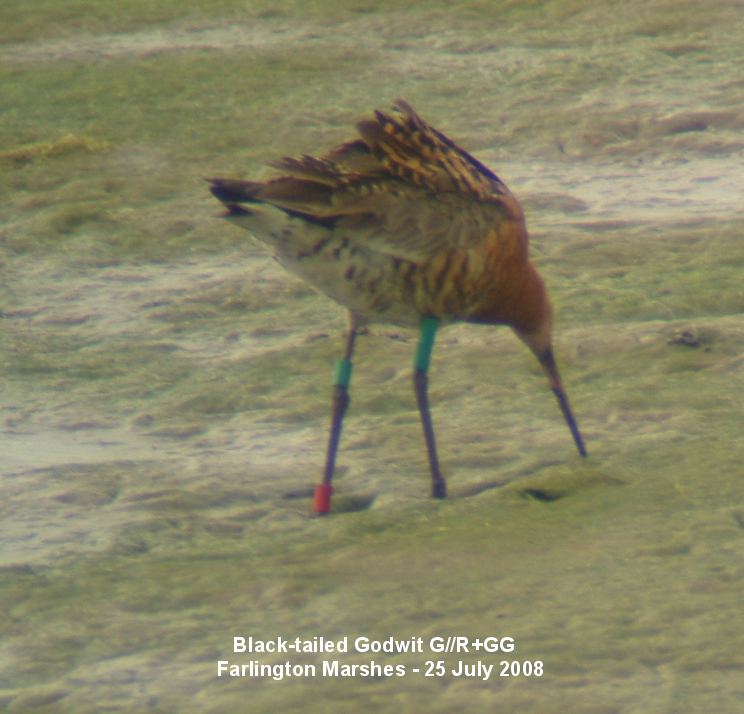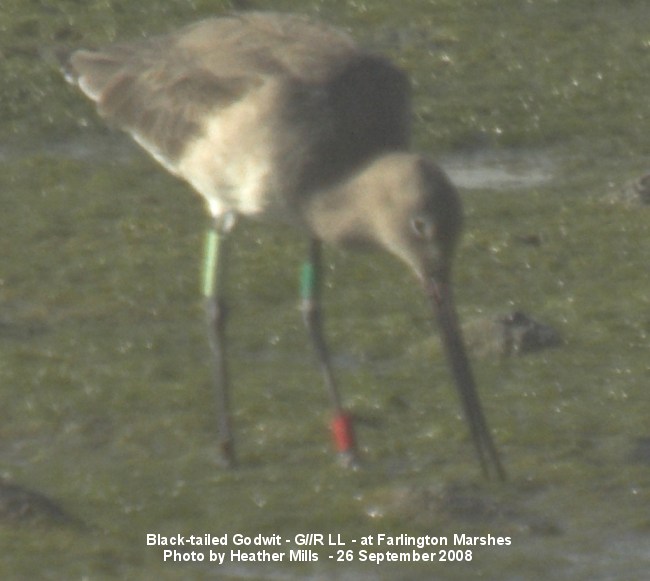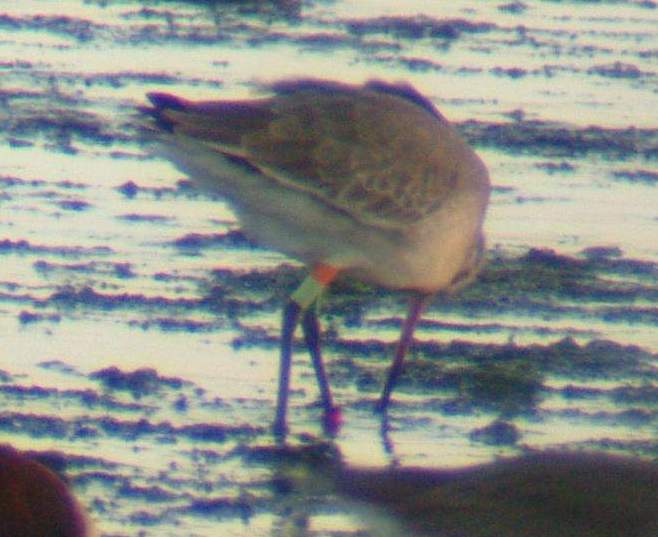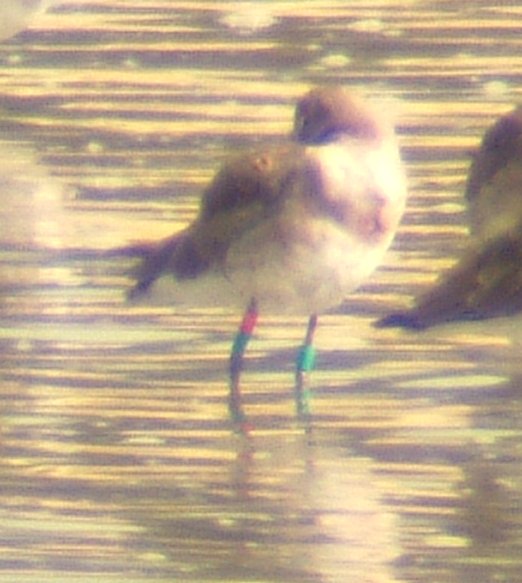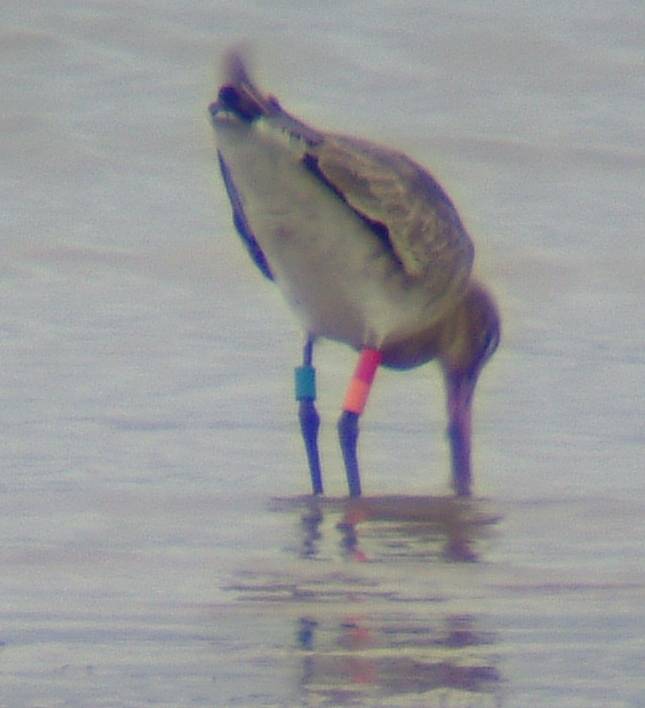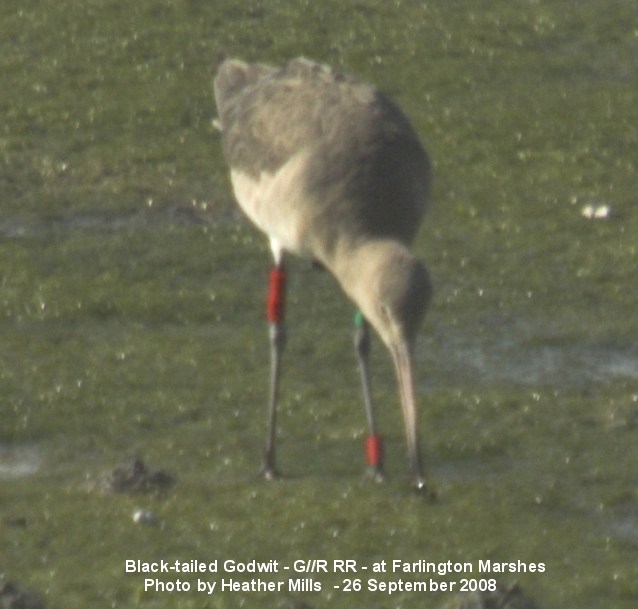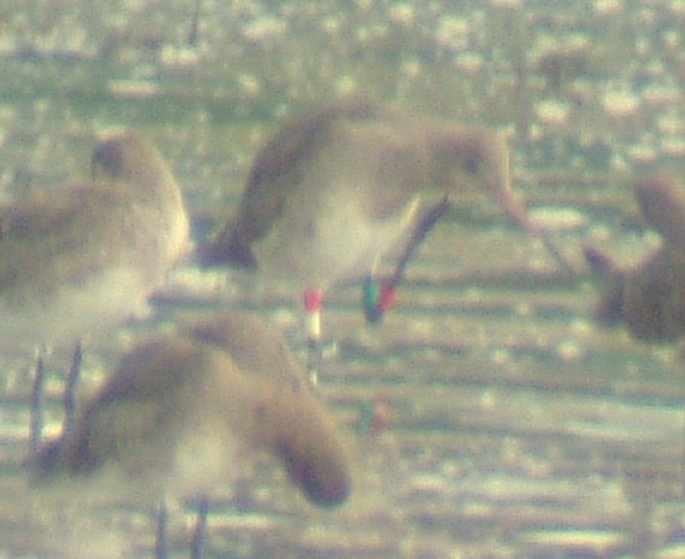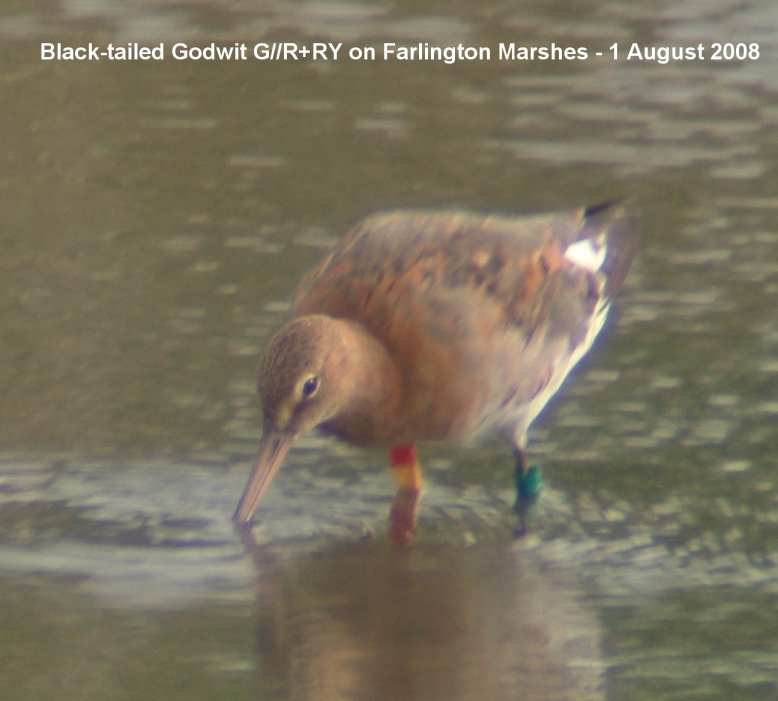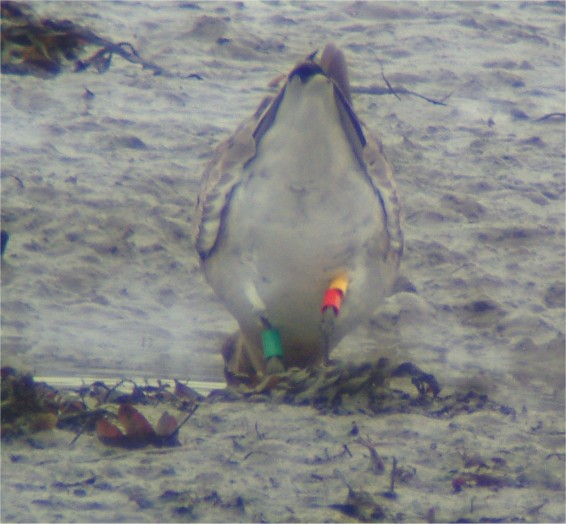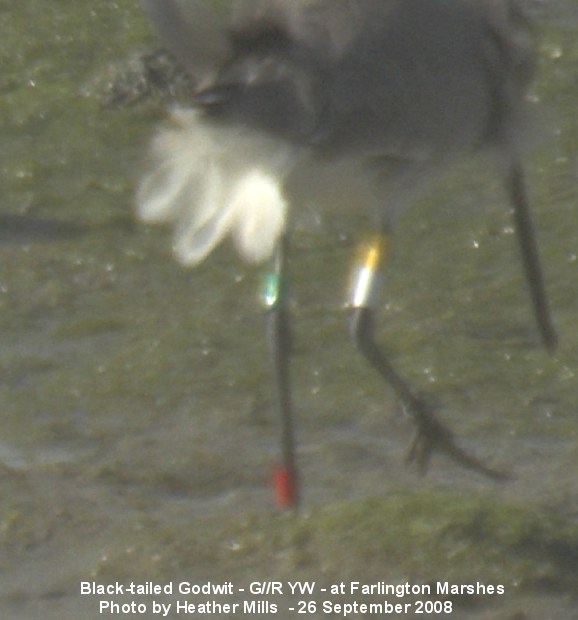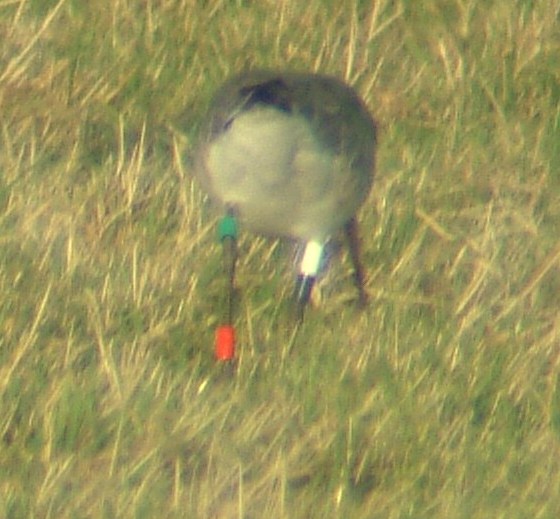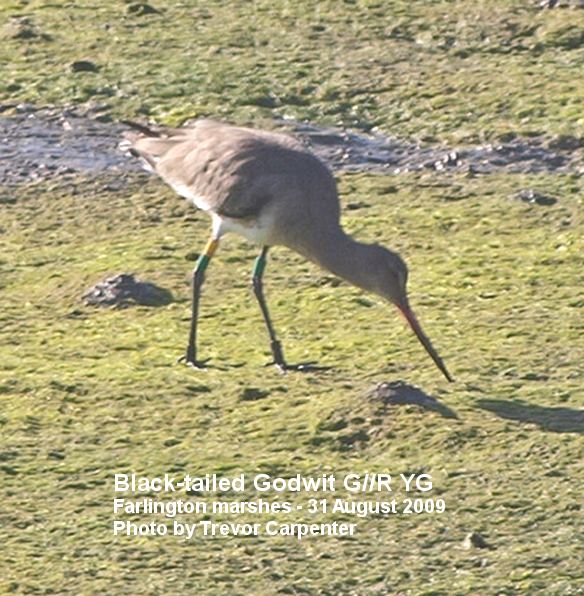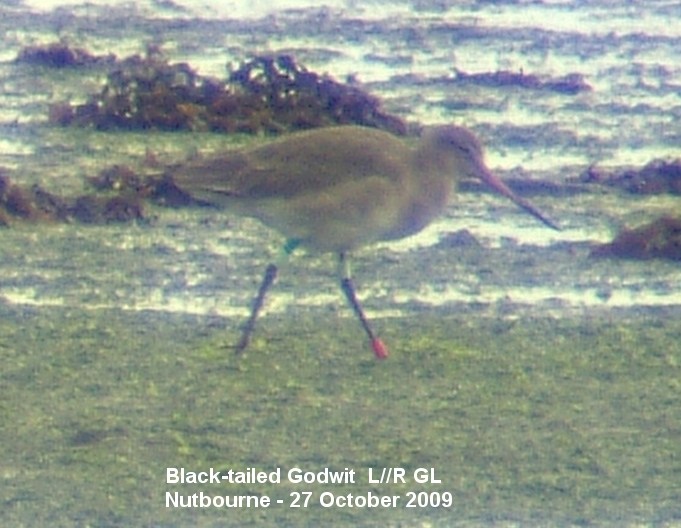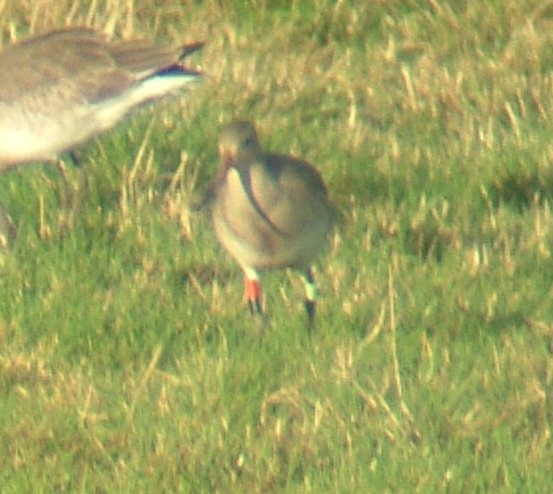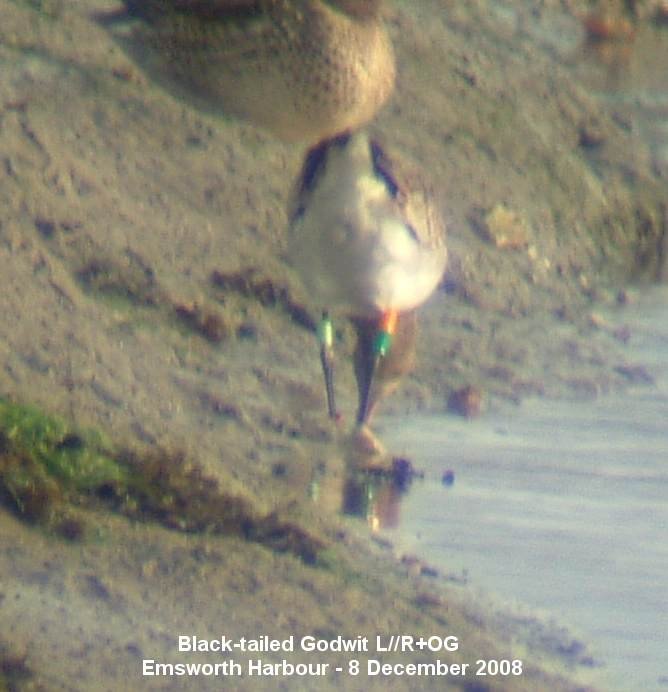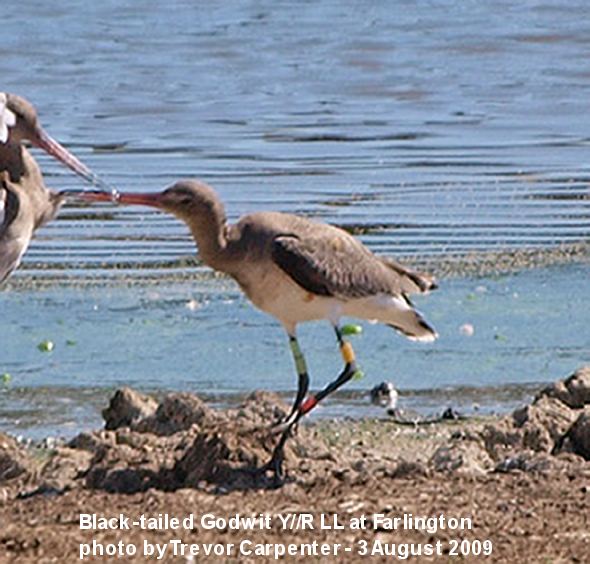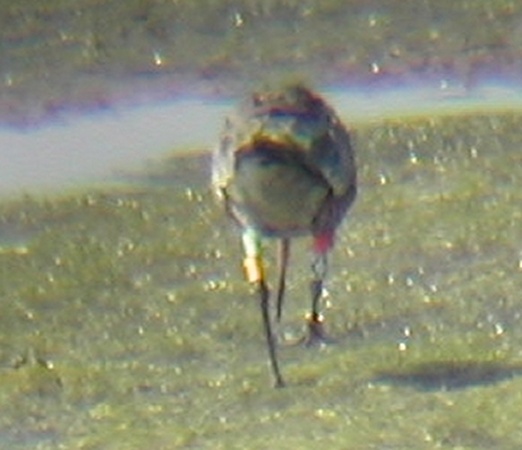RETURN TO . . . Emsworth Wildlife Homepage
COLOUR-RINGED BLACK-TAILED GODWITS
Colour-ringing information . . . Godwits season 2012-13 . . . Godwits season 2011-12 . . Spurting behaviour
Black-tailed Godwits are part of a ringing scheme by the Farlington Ringing Group. Local colour-ring sightings are reported to Pete Potts who is the local coordinator.The colour combinations are reported as follows: left leg - right leg. For example, O//R GL has orange ring on the left tibia with a red marker ring on the tarsus and a green ring above a lime ring on the right tibia. Rings are usually on the tibia (above the knee) except for a the red marker ring on the Farlington and Thorney ringed Godwits which is below the knee on the tarsus indicated by two slashes - //. For example, B//R+WW means Left leg: Blue on tibia, red on tarsus. Right leg: white over white on Tibia (no rings on the tarsus). Very often, only the three main colour rings are reported with the red marker ring assumed, e.g, R+WW or O+GL.
Birds ringed in other locations have slightly different combinations of colours: The following are the ones most likely to be seen in our local harbours.
Godwits ringed in Iceland have two colour rings on each tibia. eg GL+YL
Godwits ringed in Kent have 3 colour rings on each leg. eg RYL+RLY
This also applies to Suffolk ringed birds eg LRG+OLO
Godwits ringed in the Wash have a white ring on the lower right leg. eg R+YL//WKey to colours: R = red, Y = yellow, L = lime, O = orange, N = black, G = green, W = white, B = blue.
A6 means a white ring with 'A6' printed on it. X means a white ring with an 'X' marked on it.NOTE; In the records below the colour combinations have been simplified by leaving out the red target ring - R// - which occurs in all the combinations where there is only one colour ring on the left tibia.
EMSWORTH GODWIT RECORDS - season 2010-11I have been monitoring the Black-tailed Godwits in Emsworth Harbour for several years and have kept a log of all the colour-ring sightings. Here are the records for the 2010-11 season.
Chart showing the Black-tailed Godwit counts for 2010-11 season in Emsworth
BLACK-TAILED GODWIT COUNTS IN EMSWORTH - 2006-2007The 2006-07 winter was quite different from 2005-06 winter. Counts were fairly high from the end of October until the beginning of December, but then fell dramatically to single figures in less than a week. Counts have remained very low since that time with 9 being the best the best we could muster in December. The last were seen in January 2007.
Just where all the Godwits went this winter is a bit of a mystery. Some clearly moved west to flooded fields in the Avon Valley north of Christchurch where at least 2,000 Black-tailed Godwits were reported on 7 Jan 2007 and subsequent colour-ringed sightings showed the presence of some Emsworth birds. There were also over 700 Godwits in Pagham Harbour with some Emsworth birds there also.
NOTE: Godwit counts have remained low in all the subsequent years 2007-2009. Just why they have gone is a mystery.
BLACK-TAILED GODWIT COUNTS IN EMSWORTH - 2005-2006The winter of 2005-2006 was a bumper year for Black-tailed Godwits in Emsworth Harbour, with a maximum of 176 in early December. From February to the end of March counts were lower, but there were still several over 80.
Black-tailed Godwits in flight. What a great experience to see them take off and wheel around.
Here are a couple of good photos of this taking place, but they are no substitute for the real thing.
OPERATION GODWITOperation Godwit is an international association of people studying the Icelandic Black-tailed Godwit - Limosa limosa islandica. The aim is to unravel the population dynamics and migration strategies of the subspecies throughout its range. This is done by carrying out fieldwork in different countries and by following movements of individually colour-ringed birds. For sightings of ringed godwits they rely on the contributions of observers who send sightings of ringed birds and receive known life-histories of the ringed birds in return.
For more details see Operation Godwit web site . . . . http://www.scoiliosaefnaofa.com/God%20history.html -
The Icelandic Black-tailed godwit
The Icelandic Black-tailed godwit Limosa limosa islandica is one of the three subspecies of the Black tailed Godwit. This subspecies breeds almost exclusively in Iceland and winters in W. Europe. The main wintering countries are Ireland, Britain, France and the Netherlands but an unknown proportion of the population winters further south in Spain, Portugal and perhaps in Morocco. Our most recent (unpublished) estimate of population size suggests that the population size is ca. 15.000-20.000 pairs. The Black-tailed godwit is slightly smaller, darker in breeding plumage and significantly more beautiful than the nominate subspecies, which breeds in western Europe and winters in southern Europe and Africa.
The spring migration of the Black-tailed godwit to Iceland is from mid April to early May. Before scattering onto the breeding grounds the birds stage for a few days on mudflats and freshwater sites around Iceland and peak numbers on individual sites are usually found from 20th April-5 May. These sites can hold up to 30% of the entire population at the same time and are thus extremely important.
The Black-tailed godwit breeds in different types of wet marshes and mesic grasslands in lowland areas around Iceland. After arrival on the breeding grounds, the birds set up their territories and fatten up for 2-3 weeks before the onset of incubation in late May. Peak hatching is in mid to late June. Unsuccessful breeders start showing up on the wintering grounds already in the first days of July. Most chicks fledge in July and successful adults leave Iceland around that time, with the last adults usually having left before mid August. The now fledged chicks have to undertake the first migration on their own. Most juveniles leave Iceland in August but a few remain until September.
On the wintering grounds the birds tend to use mudflats and wet grasslands near the coast, where they feed on invertebrates such as worms and molluscs. Many of the birds move between areas throughout the winter and some use up to 4 different countries. In late January and February, birds in the southern part of the range start moving gradually northwards in preparation for the migration to Iceland in April.
Up until 1920, the Black-tailed godwit was a rare bird. They only bred in restricted areas in the southern lowlands of Iceland and the population was probably much smaller than now. After 1920 the godwits started spreading to areas in the west of Iceland and by 1930-1940 they had started breeding in the north. They established themselves as a breeding species in the east of Iceland only around 1970. General increase has occurred in all parts of the country and the godwits are found breeding in new locations every year. The reason for this population increase is not known but the possible influence of climate change, favourable habitat change or reduced hunting on the wintering grounds have all been suggested. The Black-tailed godwit has never been hunted in Iceland.
GODWIT NEWS FROM ICELAND 2010CHICK RINGED IN ICELAND MAKES IT TO EMSWORTH
17 November 2010 - Pete Potts confirmed the really exciting news that the colour-ringed Black-tailed Godwit WO LW flag, which has been seen in Bosham (Nov 6) and Emsworth (Nov 14 and Nov 16), was indeed a chick ringed in north Iceland last summer by Ruth Croger and Pete on 13th July at Langhus, SW of Siglufjordur. Pete adds that this big chick was caught by their good friend Laki on his farm using his jumper as the bird escaped from his hay cutting! Pete thinks this is only the 4th godwit chick that has turned up in The Solent, that will probably winter here, from all over Iceland! He says 2-3 others have been seen on autumn migration on odd days on their way south but never resighted here. So that is some catch for us! We shall keep a good look out for it.
Ruth Croger subsequently posted an image of LO LW flag as it was ringed by Andy Welch at Langhus Farm, together with a shot of the habitat where it was caught. The farm is in North Iceland at 66 degrees north, so the horizon shown in the photo is probably in the Arctic Circle.
NOTE; Ruth apologised for sending the wrong picture of the Godwit chick. Inadvertantly she sent LO LW flag (as shown below) instead of WO LW flag. Ruth does not have an image of WO LW flag, but thinks Pete may have one. I did not notice the mistake! However, not to worry, as I am sure the two birds are pretty similar.
Godwit LO LWflag ringed in Northern Iceland on 13th July 2010
Ruth's mistake alerted me to a mistake I also made with the labelling of the photos of our Godwit WO LW flag - now corrected. These colour-rings are so easy to get muddled up.
Here is the Godwit WO LW flag in Bosham Harbour
This is the farmland in Iceland where the Godwit was caught
SUMMER 2008 IN ICELANDReport from Pete Potts
I thought you might like to know how we got on this summer in Iceland. The Operation Godwit team (Ruth Croger & myself from Farlington Ringing Group, Guillaume Gelinaud from Brittany, Astrid Kant from Holland, John & Helen Swallow, David & Elizabeth Price) visited Iceland between 3rd-20th July. Ruth, Guillaume Astird and myself for the whole period. John & Helen, David & Elizabeth joined us for shorter periods. Guillaume stayed on to do some more fishing afterwards with Tomas.
We concentrated on our study sites in NW Iceland and between Akureyri and Siglufjordur on the central north coast. This is now the 4th year we have visted these sites and the 9th summer of godwit fieldwork in Iceland since we started in 1999 missing just 2003. I think this was my 16th or 17th trip to Iceland almostly exclusively for godwits!
Anyway so how did we get on. In summary it seems to have been another early season and further advanced by a week to ten days on last year following good weather since I think middle of May. Consequently we struggled to ring many godwit chicks, however we did manage to ring 54, this is our lowest total since 2004. Most were large chicks, so they should stand a good chance of being seen again with luck!
We also colour-ringed 24 adult godwits - one nest trapped and the rest cannon-netted in small catches. The total would have been higher if we hadn't opted to use the new light weight cannons/projectiles which require different powder quantities to fire a net successfully and not test fire them first with different nets! I learnt the hard way loosing 17 of the 20 godwits in the catch area when the net didn't go out very far! I have since done some test fires so we are better placed for next summer.
We also saw a lot of colour-ringed adults c.44-46 combinations, including 2 Farlington ringed birds: W//R+GL (Siglufjordur on 16th July) and G//R+RO (Reykholar, NW Iceland on 10th July) neither were breeding but in flocks etc. also birds we ringed in Lisbon, Brittany, one from La Rochelle, 3 from The Wash, and many we have previously ringed in Iceland, including c.12 we marked as chicks in previous years largely returning to their natal areas. This is the first real data for any number of birds we have for site fidelity to natal areas for the islandica race. This will grow as they project develops.
We managed to ring 249 birds, mostly waders. 10 species of wader chick including Purple Sandpiper (1), Dunlin (3), RN Phalarope (2) and Snipe (2) which are never easy to get and rarely all on one trip when we focuses so much on godwits! We only ringed 9 Golden Plover chicks which is very poor.
The remaining wader totals were: 11 Oystecatcher, 23 Ringed Plover, 39 Whimbrel, 48 Redshank and 78 godwits. Also 31 Arctic Terns and a BH Gull. We ringed the Terns to help with a PhD study collecting blood and feather samples as well as biometric data.
The weather was incredible, much sunshine and temperatures up to 19 and frequently 15-16 in NW Fjords which felt hot and is warm by Iceland standards. We had rain on just 2-3 days. In some parts of Iceland they had not had rain for 10 weeks and many of the rivers were very low and some almost dried up. The Snaefellsnes glacier looks smaller than ever and will I am sure be gone in 10-20 years perhaps if global warming continues at this rate, but I took a few pictures so I can remind myself what it looks like! Perhaps I am wrong.
The Siglufjordur catch was attended by some local school children who are doing a project on the godwits linked via the internet with a school in Cork. They were very enthusiastic and loved it despite us only catching 3 birds! Next year...
Other bird/wildlife highlights: several WT Eagles and several Gyr Falcons both seen daily at various sites, SE Owls, Merlins, RN Phalarope brooding its tiny chicks at close range after we had ringed them. The call of the Great Northern Diver. A loch with not only 2 pairs of Slavonian Grebes feeding their chicks but also 8-10 pairs of RT Divers calling and displaying next to us as we processed our catch of 16 godwits close to mid-night. A brood of Long-tailed Ducks crossing the track in front of the car. Also two Arctic Foxes at the end of the trip something we don't often see. We didn't go on any whale watching trips this year as we ran out of time for second year running!
Lastly a big thank you to the all the team members for all their hard work, long days, irregular and scarce meals, long drives and paitence. Thank you Ruth for booking flights, cars and accommodation. Thanks to Guillaume for all the fresh fish you caught and prepared for us just brilliant, thanks to Astrid esp. for all the photographs and lecture on limosa breeding ecology in The Netherlands and showing us your great books!
Thank you also of course to our hosts for accommodation, food and most important of all your great friendship and companionship: Yann, Boddi og Peta, Tomas og Linda, Lakki og Luka and Gudny og Orlygur and families. Also to Mummi, Gunni and Tomas for loan of ringing kit and rings.
OK enough! Trust all's well, keep up the good work recording all those ringed godwits & greenshanks etc it is so much appreciated by the team.
MORE PHOTOS OF COLOUR-RINGED GODWITS
All by Brian Fellows unless otherwise stated.
Farlington Ringed Godwits
Left leg - BLUE
B//R WW - (Emsworth) - 02.11.07
B//R YL- (Emsworth) 26.11.06
Left leg - GREENG//R GG - (Farlington) - 25.07.08
G//R GY - (Broadmarsh) - 04.09.07
G//R LL - (Farlington) (photo by Heather Mills) - 26.09.08
G//R OL - (Emsworth) 06.12.06
G//R RG - (Broadmarsh) - 04.09.07
G//R RO - (Langstone) 09.03.06
G//R RR - (Farlington) (photo by Heather Mills) - 26.09.08
G//R RW - (Broadmarsh) - 04.09.07
G//R+RY - (Farlington) - 01.08.08
G//R YR - (Emsworth) - 31.01.06
G//R YW - (Farlington) (photo by Heather Mills) - 26.09.08
G//R WN (Pagham) - 19.11.08
G//R WR - Pagham - 19.11.08
G//R YG (Farlington) (photo by Trevor carpenter) - 31.08.09
Left leg - LIMEL//R GL (Nutbourne) -27.10.09
L//R GY (Pagham) - 11.02.09
L//R LL - Emsworth 06.11.09
L//R LO (Pagham) - 19.11.08
L//R OG (Emsworth) - 08.12.08
L//R+OO - (Fishbourne) - 17.10.08
L//R RL (Farlington) - 17.09.08
L//R RO (Farlington) - 08.09.09 (photo by Trevor Carpenter)
Y//R RN - Emsworth - 17.1.09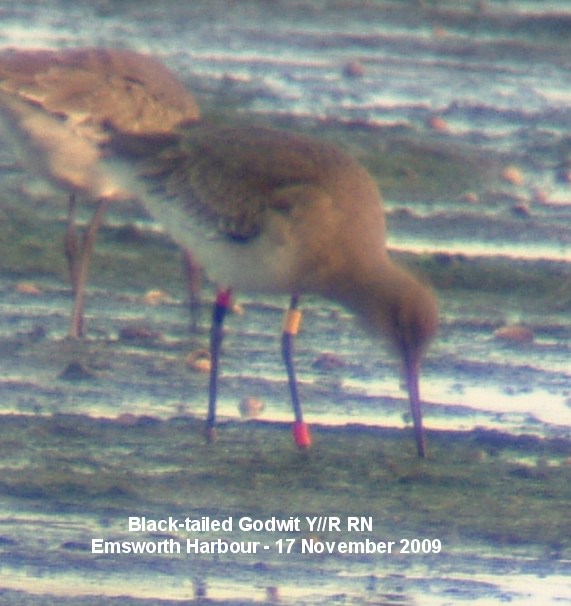
Y//R LL - Farlington - 03-Aug-09 - (photo by Trevor Carpenter)
Y//R RG - Emsworth 06.11.09
LY OX - (Emsworth) - 15.08.02I first saw this one in Emsworth in 2002 which I first thought was LY RX. Since then it has been seen at Farlington and Fishbourne and most recently by Anne de Potier off Salterns Copse on the east side of Chichester Harbour, near Chichester Marina, Anne de Potier says LY OX used to visit the Deeps in Aug/Sept in 2002-5 (Barry), and she saw it at Nutbourne on 2 Sept 05. No further news until Aug 2008 at Birdham (Nick), so now it seems to prefer the east side.
YL LR - Emsworth - 17.1.09